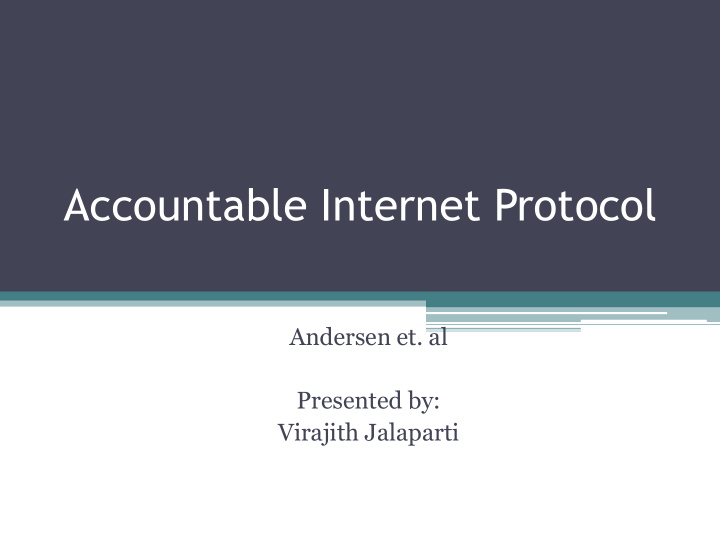



Accountable Internet Protocol Andersen et. al Presented by: Virajith Jalaparti
Securing the Internet • S-BGP, so-BGP, PG-BGP, StopIt, Listen & Whisper… • Fundamental Problem ▫ No Accountability • Use CRYPTO!!! ▫ source spoofing ▫ DOS ▫ route hijacking ▫ route forgery • Can we do this without loosing aggregation? • How can we get anonymity?
AIP • Self-certifying addresses • Use my public key as my address • How to scale to size of Internet? ▫ Network identifier Accountability Domains (ADs) ▫ End Host Identifier • AD : EID : iface • Other ways? ▫ DHT of mapping from addresses to keys? • EID associated with user rather than host
AIP • stack of src and dest AD’s
Routing • Inter-domain ▫ At AD level rather than AS level Practical? Contracts between ASes • Intra-domain ▫ Use EIDs ▫ Probably lots of entries in tables?
Source Spoofing • First hop router verifies • Should be done at switch level
Source Spoofing ▫ Is this sufficient? What happens after verification is passed? First packet is a TCP-SYN, replay possible – use a nonce Explicit tear down of connection
Inter-domain verification • B -> A ▫ A trusts B ▫ uRPF check ▫ Send a verification packet • Border routers verify src addresses and add to accept cache ▫ Wildcard AD:* to bound number of entries ▫ can be exploited, it the checks in src AD does not perform proper checks
Minting of addresses • Start connections with arbitrary EID • Easy • Solution ▫ Limit number of EIDs per interface on switches/routers AD • Is this sufficient? • Cant prevent a DOS using minting ▫ Using Bots
Shut-off Protocol • Prevent DOS • Use smart NIC ▫ require physical access to modify the firmware • cache packets sent • Protects against replays • Is this sufficient? ▫ Flooding attacks with bot-nets
Key Management • Discovery ▫ DNS - Secure • Detect compromise ▫ Use of global registries Keys Revoked Keys Peerings ADs of EID First hop routes • Dealing with compromise ▫ Change DNS record, insert new key • Will this work? Requires out of band techniques to fix
Discussion • Does it work? • Is it practical? • Distribution of keys • Possibility of creating optimal ADs? • Probably run in combination with IP • Application (Routing!) level security
Recommend
More recommend